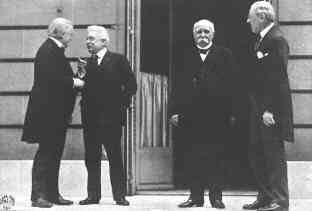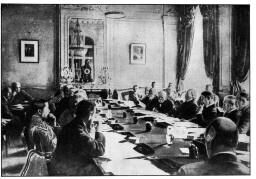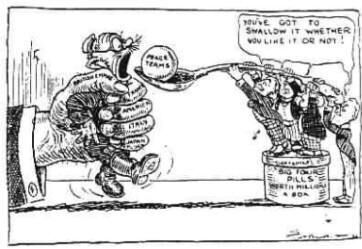


The military hostilities of World War One ended at 11am on 11th November 1918 but a final diplomatic end of the war was not reached until the signing of the Treaty of Versailles. In 1919, Lloyd George of England, Orlando of Italy, Clemenceau of France and Woodrow Wilson from the US met to discuss how Germany was to be made to pay for the damage world war one had caused.
Wilson had devised a 14 point plan that he believed would bring stability to Europe.
Germany expected a treaty based on these fourteen points. However, negotiations between the ‘big four’ Lloyd George of England, Orlando of Italy, Clemenceau of France and Woodrow Wilson of America did not go smoothly. Wilson believed that his fourteen points was the only way to secure everlasting peace. The French however, wanted the defeated nations to be punished severely and believed Wilson’s plan too lenient. Privately Lloyd George sided with Wilson although he was concerned about the threat from Communism, however, the British public, like Clemenceau, wanted Germany punished severely. Lloyd George knew that if he sided with Wilson he would lose the next election.

After prolonged discussion agreement was eventually reached. The Germans were summoned to Versailles to sign the treaty on 28th June 1919.
The final treaty bore little resemblance to Wilson’s fourteen points:

Although Germany was not happy with the Treaty they had little choice but to sign. This cartoon clearly shows the situation Germany was in.
There were a total of 440 clauses in the final treaty. The first 26 clauses dealt with the establishment of the League of Nations. The remaining 414 clauses spelled out Germany’s punishment.
The establishment of the League of Nations
War Guilt clause – Germany to accept blame for starting the war.
Reparations – Germany was to pay for the damage caused by the war. The figure of £6,600 million was set some time after the signing of the treaty.
Army – was to be reduced to 100,000 men and no tanks were allowed
Navy – Germany was only allowed 6 ships and no submarines
Airforce – Germany was not allowed an airforce
Rhineland – The Rhineland area was to be kept free of German military personnel and weapons
Anschluss – Germany was not allowed to unite with Austria.
Land – Germany lost land to a number of other countries. Alsace-Lorraine was returned to France, Eupen and Malmedy were given to Belgium, North Schleswig was given to Denmark. Land was also taken from Germany and given to Czechoslovakia and Poland. The League of Nations took control of Germany’s colonies
This map shows the areas that Germany lost following the Treaty of Versailles
The Treaty of Versailles determined the punishment that Germany should face. Other treaties determined the fate of those countries that had fought with Germany – Austria-Hungary, Bulgaria and Turkey. Austria and Hungary were divided and therefore signed separate treaties
Land – Austria lost land to Italy, Czechoslovakia and Serbia (Yugoslavia).
Army – To be reduced to 30,000 men.
Anschluss – Union with Germany was forbidden
Reparations – Austria was to pay reparations but went bankrupt before the rate could be set.
Land – Hungary lost land to Austria, Czechoslovakia, Romania and Serbia (Yugoslavia) reducing its size from 283,000 sq km to less than 93,000 sq km. Population was reduced from 18.2 million to 7.6 million.
Army – To be reduced to 35,000 men
Reparations – Hungary was to pay reparations but the amount was never set
Land – Bulgaria lost land to Greece, Romania and Serbia (Yugoslavia).
Reparations – Bulgaria had to pay 90 million pounds in reparations
Army – restrictions were made on the size of Bulgaria’s army
Land – Turkey lost land to Greece. The League of Nations took control of Turkey’s colonies.
This article is part of our larger selection of posts about World War One. To learn more, click here for our comprehensive guide to World War One.


PODCAST: HISTORY UNPLUGGEDOn the Eve of World War One, Woodrow Wilson, Teddy Roosevelt, and the Suffragette Jane Addams Sought to Prevent Armageddon
"World War One – The Treaty of Versailles" History on the Net
© 2000-2024, Salem Media.
September 11, 2024
More Citation Information.